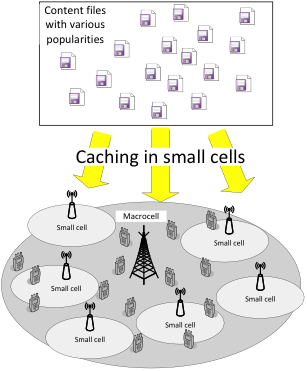Mobile Content Delivery
In order to cope with the dramatic growth of data traffic in wireless cellular networks, mobile network operators deploy more and more small cell base stations (SBS) to cooperate with traditional macro cell base stations (MBS) in recent years. This resulting network with a mix of SBSs and MBSs is referred to as heterogeneous cellular networks (HCN). HCNs help to improve the spatial spectral efficiency of the network and have attracted significant attention from both academia and industry. In the 5th-generation (5G) system, the density of SBSs may even increase to a level to be comparable to the density of mobile users.
A main reason driving the growth of data traffic is the dramatic-increasing streaming of video on demand files. In the next five years, on-demand video streaming may increase by two orders of magnitude. To cope with the challenge of on-demand video streaming, the idea of caching contents in advance has been proposed. That is, video files are transmitted to and stored in the networks during the off-peak time. Then the users can download the files at the peak time.
Various caching strategies are proposed and analyzed recently, for instance, FemtoCaching, device-to-device (D2D) caching and caching in social networks. FemtoCaching utilizes the SBSs (e.g., femto cell base stations, WiFi access points) in HCNs to cache the video files, using the storage capacity of SBSs to augment the backhaul capacity in the network. The high deployment density of SBSs and their short distances from mobile users, provide good basis for the storage and transmission of files. Compared with D2D caching where the files are stored in mobile users, FemtoCaching has the advantage of open access and sufficient power supply.
FemtoCaching strategies can be mainly divided into two classes, deterministic caching and random caching (RC). The deterministic caching uses the location of mobile users and channel state information (CSI) as a priori knowledge to find out the optimal file storage. In a RC scheme, files are stored according to certain caching distribution, i.e., the fraction of the SBSs that cache each file. Different RC scheme can have different caching distributions. Generally, compared with deterministic caching, the random caching has a lower cost and is more robust for practical applications. An illustrative graph of random caching is shown in Fig. 1.
Illustration of the random caching
Objective
To find the optimal caching strategy for random caching in the sense that the successful download probability of cached files from small cells is maximized.
Research topics
- Efficient data transmission in small cell networks
- Network analysis for networks with small cell caching
- Investigate the tradeoff between the density and the transmission power of the SBSs
- Investigate more realistic activities of video requesting
- File grouping schemes for small cell caching
- Optimal caching strategies
Approaches
- Theoretical analysis based on stochastic geometry
Collaborations
- The University of Sydney
Recent publications
- Ming Ding, David López Pérez, Ruiqi Xue, Thanos Vasilakos, and Wen Chen, “On Dynamic Time Division Duplex Transmissions for Small Cell Networks,” to appear in IEEE Transactions on Vehicular Technology.
- Peng Wang, Guoqiang Mao, Zihuai Lin, Ming Ding, Weifa Liang, Xiaohu Ge, and Zhiyun Lin, “Performance Analysis of Raptor Codes under Maximum-Likelihood (ML) Decoding,” to appear in IEEE Transactions on Communications.
- Youjia Chen, Ming Ding, Jun Li, Zihuai Lin, Guoqiang Mao and Lajos Hanzo, “Probabilistic Small-Cell Caching: Performance Analysis and Optimization,” submitted to IEEE Transactions on Vehicular Technology.
- Ming Ding, David López Pérez, Thanos Vasilakos, and Wen Chen, “Analysis on the SINR Performance of Dynamic TDD in Homogeneous Small Cell Networks,” IEEE Globecom 2014, Austin, USA, pp. 1552-1558, Dec. 2014.
Recent activities
- Ming Ding served as the Guest Editor of the IEEE Communications Magazine feature topic on unmanned aerial vehicles (UAVs) in 2015.(http://www.comsoc.org/commag/cfp/wireless-communications-networking-and-positioning-unmanned-aerial-vehicles)

